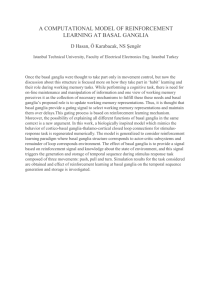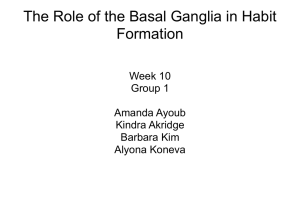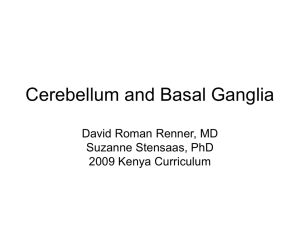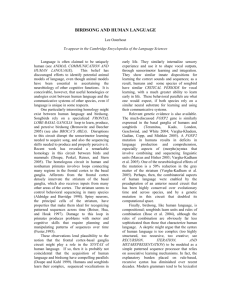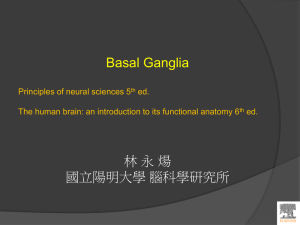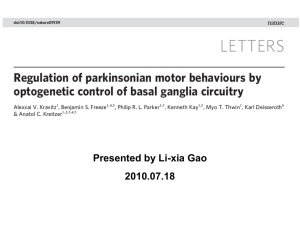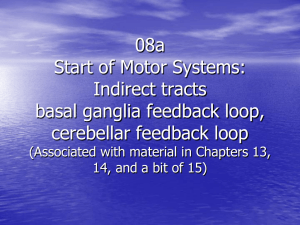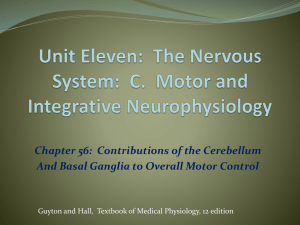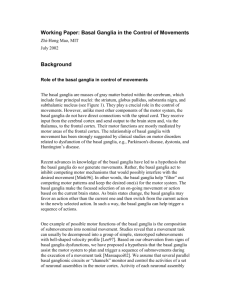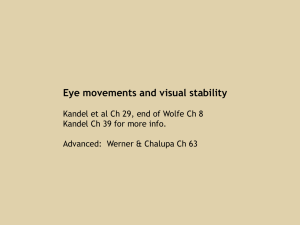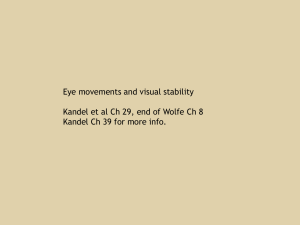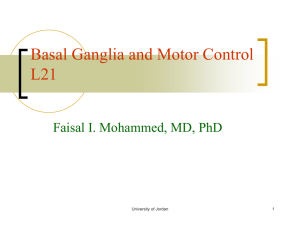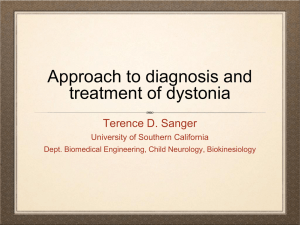sms7new
advertisement
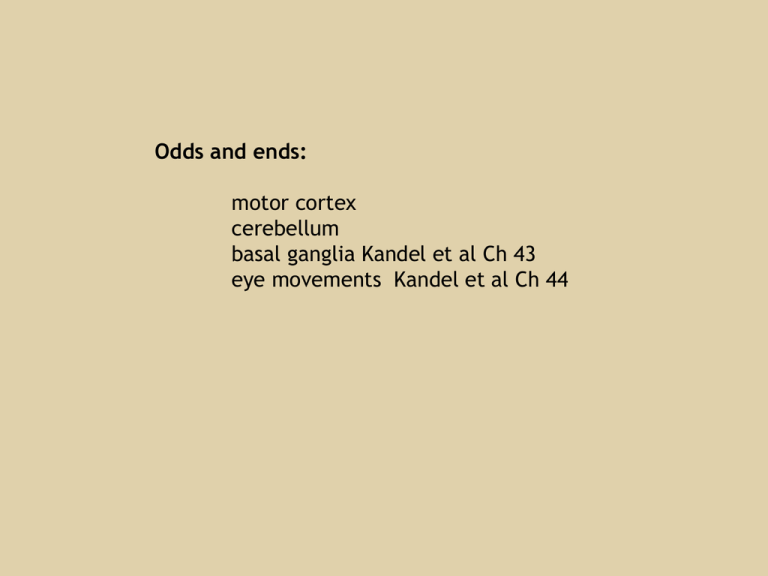
Odds and ends: motor cortex cerebellum basal ganglia Kandel et al Ch 43 eye movements Kandel et al Ch 44 Coding in Motor Cortex (ctd) Graziano et al, 2002: prolonged electircal stimulation (500 msec) leads to adoption of particular postures. Lines show arm trajectory from random starting point Other cells: movement amplitude, direction, speed But note other findings that M1 cells code force Consequences of cerebellar damage: Flaccidity in primates, rigidity in cats - Consequence of changes in sensitivity of spinal reflex circuits. Ataxia = lack of coordination Disarthria = slurred speech Nystagmus = eye drift followed by rapid corrections Hypermetria = overshoot when pointing to a target Intention tremor = oscillating limb when pointing Unilateral cerebellar damage: subjects alternates palm up – palm down normal damaged Similar effects of alcohol Different regions of the cerebellum involved in different aspects of motor control. Laetral regions active before movement. Medial regions active during movement. The relationships of the basal ganglia to the major components of the motor system. The basal ganglia and cerebellum may be viewed as key elements in two parallel reentrant systems that receive input from and return their influences to the cerebral cortex through discrete and separate portions of the ventrolateral thalamus. They also influence the brain stem and, ultimately, spinal mechanisms. The four principal nuclei of the basal ganglia are (1) the striatum, (2) the globus pallidus (or pallidum), (3) the substantia nigra (consisting of the pars reticulata and pars compacta), and (4) the subthalamic nucleus. The striatum consists of three important subdivisions: the caudate nucleus, the putamen, and the ventral striatum (which includes the nucleus accumbens). The striatum is divided into the caudate nucleus and putamen by the internal capsule, a major collection of fibers that run between the neocortex and thalamu in both directions. Striatum = caudate+putamen The striatum receives input from nearly all the cerebral cortex. Functionally related cortical areas project to overlapping striatal zones and an individual cortical area projects to several striatal zones. Cortical areas not functionally related project to separate zones of the striatum, although there may be some interaction between adjacent zones. 2. The striatum sends a focused and convergent inhibitory projection to the basal ganglia output nuclei, GPi and SNpr. 3. The STN receives input from the frontal lobe, especially from the motor, premotor, and supplementary motor cortex and from the frontal eye fields. 4. The STN sends a fast divergent excitatory projection to GPi and SNpr. 5. Reciprocal and loop-like connection among basal ganglia nuclei that may play a negative or positive feedback role or may result in focusing of signals. 6. The output from the basal ganglia (GPi and SNpr) is inhibitory and projects to motor areas in the brain stem and thalamus. 7. There are no direct connections between the basal ganglia and the spinal sensory or motor apparatus. + + Changes in the activity of basal ganglia occur at the onset of movement but after the muscles are already active. Thus, they are unlikely to initiate movement. The striatum is the major recipient of inputs to the basal ganglia from the cerebral cortex, thalamus, and brain stem. Its neurons project to the globus pallidus and substantia nigra. These two nuclei, give rise to the major output projections from the basal ganglia. The anatomic connections of the basal ganglia-thalamocortical circuitry, indicating the parallel direct and indirect pathways from the striatum to the basal ganglia output nuclei. Two types of dopamine receptors (D1 and D2) are located on different sets of output neurons in the striatum that give rise to the direct and indirect pathways. Pink =excitatory Gray= inhibitory The frontal lobe targets of the basal ganglia-thalamocortical circuits. ACA = anterior cingulate area; FEF = frontal eye field; MOFC = medial orbitofrontal cortex; PMC = premotor cortex; SEF = supplementary eye field; SMA = supplementary motor area. dorsolateral prefrontal ctx lateral orbitofrontal ctx primary motor crtx Hypokinetic disorders (eg Parkinson disease) characterized by impaired initiation of movement (akinesia) and reduced amplitude and velocity of voluntary movement (bradykinesia). Usually accompanied by rigidity) and tremor. Hyperkinetic disorders (Huntington disease and hemiballismus) characterized by excessive motor activit, - involuntary movements (dyskinesias) and decreased muscle tone (hypotonia). The involuntary movements may be slow, writhing movements of the extremities (athetosis); jerky, random movements of the limbs and orofacial structures (chorea); violent, large-amplitude, proximal limb movements (ballism), and more sustained abnormal postures and slower movements with underlying cocontraction of agonist and antagonist muscles (dystonia). Darker arrows increased activity Lighter arrows decreased activity Neurons in substantia nigra pc in basal ganglia release dopamine. These neurons signal expected reward. Cells do not discharge during movement. SNpc likely to play a critical role in some types of motor learning. Dopaminergic neurons in basal ganglia signal expected reward. (Schultz, 2000) SNpc Response to unexpected reward Increased firing for earlier or later reward Expected reward is absent. Hypotheses about basal ganglia function: 1. basal ganglia do not initiate movement, they contribute to the automatic execution of movement sequences. Other mechanisms initiate the first component in a sequence, but that basal ganglia contain the programs for completion of the sequence. 2. the basal ganglia circuitry is made up of opposing parallel pathways that adjust the magnitude of the inhibitory GPi output in order to increase or decrease movement. Increased GPi output slows movements and decreased GPi output increases movement. 3. basal ganglia act to permit desired movements and to inhibit unwanted competing movements. Why do we move our eyes? - Image stabilization - Information acquisition Visual Acuity matches photoreceptor density Why do we move our eyes? 1. To bring objects of interest onto high acuity region in fovea. Cone Photoreceptors are densely packed in the central fovea Why eye movements are hard to measure. A small eye rotation translates into a big change in visual angle Visual Angle x 18mm a d tan(a/2) = x/d a = 2 tan 1 x/d 1 diopter = 1/focal length in meters 0.3mm = 1 deg visual angle 55 diopters = 1/.018 Why do we move our eyes? 1. To bring objects of interest onto high acuity region in fovea. 2. Cortical magnification suggests enhanced processing of image in the central visual field. Oculomotor Muscles Muscles innervated by oculomotor, trochlear, and abducens (cranial) nerves from the oculomotor nuclei in the brainstem. Oculo-motor neurons: 100-600Hz vs spinal motor Neurons: 50-100Hz Types of Eye Movement Information Gathering Voluntary (attention) Stabilizing Reflexive Saccades vestibular ocular reflex (vor) new location, high velocity (700 deg/sec), body movements ballistic(?) Smooth pursuit optokinetic nystagmus (okn) object moves, velocity, slow(ish) whole field image motion Vergence change point of fixation in depth slow, disjunctive (eyes rotate in opposite directions) (all others are conjunctive) Note: link between accommodation and vergence Fixation: period when eye is relatively stationary between saccades. Retinal structure Accomodation:tension on zonule fibres VOR Latency of vestibular-ocular reflex=17msec “main sequence”: duration = c Amplitude + b Min saccade duration approx 25 msec, max approx 200msec Demonstration of “miniature” eye movements Drift Micro-saccades tremor It is almost impossible to hold the eyes still. What’s involved in making a saccadic eye movement? Behavioral goal: make a sandwich Sub-goal: get peanut butter Visual search for pb: requires memory for eg color of pb or location Visual search provides saccade goal - attend to target location Plan saccade to location (sensory-motor transformation) Coordinate with hands/head Calculate velocity/position signal Execute saccade/ Brain Circuitry for Saccades 1. Neural activity related to saccade 2. Microstimulation generates saccade 3. Lesions impair saccade Dorso-lateral pre-frontal V1: striate cortex Basal ganglia Oculomotor nuclei Function of Different Areas monitor/plan movements target selection saccade decision saccade command inhibits SC (where to go) V H signals to muscles (forces) Posterior Parietal Cortex reaching Intra-Parietal Sulcus: area of multi-sensory convergence grasping LIP: Lateral Intra-parietal Area Target selection for saccades: cells fire before saccade to attended object Frontal eye fields Voluntary control of saccades. Selection from multiple targets Relates to behavioral goals. Supplementary eye fields -Saccades/Smooth Pursuit -Planning/ Error Checking -relates to behavioral goals Pre-motor neurons Motor neurons Motor neurons for the eye muscles are located in the oculomotor nucleus (III), trochlear nucleus (IV), and abducens nucleus (VI), and reach the extraocular muscles via the corresponding nerves (n. III, n. IV, n. VI). Premotor neurons for controlling eye movements are located in the paramedian pontine reticular formation (PPRF), the mesencephalic reticular formation (MRF), rostral interstitial nucleus of the medial longitudinal fasciculus (riMLF), the interstitial nucleus of Cajal (IC), the vestibular nuclei (VN), and the nucleus prepositus hypoglossi (NPH). Brain areas involved in making a saccadic eye movement Behavioral goal: make a sandwich (learn how to make sandwiches) Frontal cortex. Sub-goal: get peanut butter (secondary reward signal - dopamine - basal ganglia) Visual search for pb: requires memory for eg color of pb or location (memory for visual properties - Inferotemporal cortex; activation of color - V1, V4) Visual search provides saccade goal. LIP - target selection, also FEF Plan saccade - FEF, SEF Coordinate with hands/head Execute saccade/ control time of execution: basal ganglia (substantia nigra pars reticulata, caudate) Calculate velocity/position signal oculomotor nuclei Cerebellum? Relation between saccades and attention. Saccade is always preceded by an attentional shift However, attention can be allocated covertly to the peripheral retina without a saccade. Pursuit movements also require attention. Superior colliculus Brain Circuitry for Pursuit & Supplementary Smooth pursuit Velocity signal Early motion analysis RF reticular formation VN vestibular nucle PN , pontine nucleii Cerebellum OV oculomotor vermis VPF ventral paraflocculus FN fastigial nucleus Visual Stability
